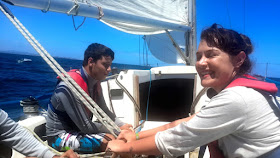Sometimes I wonder just how language affect our normal thinking and the way we go about our business. The last week is a case in point.
I already know about negative self talk and language. The stuff that the little voice in the back of your head tells you to scare you. You go surfing, for example, and when you see the size of the waves the little voice goes: “You're gonna get dumped.” And, of course, you do. It is because one tends to listen to this little voice, instead of ignoring it.
 |
| Idyllic dusk scene at Saldanha Bay Yacht Club |
Your inner self is strong enough to ignore this voice. Train yourself not to react to every input that you get from this part of your environment. Just like you train yourself not to listen to your small child misbehaving in public.
When you get to this same idea applied to a group, things get more interesting. You are now faced with a group-wide thinking pattern and group behaviour. Add in a sailing vessel of suitable size and you can have lots of fun.
Which is what happened the last week.
The boat was in Langebaan area about sixty odd nautical miles from Cape Town and had to be brought back to base. Not a big problem, I have done the trip several times. However, this time I had people on board that literally got on a sail boat the day before. This was not my making, but dictated by a suitable weather window. You wait for a north-westerly breeze to have a down-wind or broad reach sail back to home.
I made a very shortened lecture on docking the boat and reefing the sail, a long lecture on basic safety aboard, smoking practice and so on, then we set off. I taught these students basic knots on the way, names of the parts of the boat and as well as the names of the various lines. All a bit backwards, as I normally do these things on the first day and a half, before we go sailing. This helps with getting the new knowledge sinking in.
 |
| Our favourite seal |
Then, on the next day, the fun started.
Not having gone through the mill of getting the names and uses of the various lines under the belt properly, my intrepid group of students now had to remember the names of the lines very fast. I found a corner of Table bay with a breeze gusting to twenty knots where we could play around learning to sail.
Needless to say, I had a few glorious laughs watching the students' eyes grow wide in fear of the boat capsizing. We dipped a rail several times and had the mast just off the water once or twice. I had to step in several times to undo cleated lines. This dumps the wind out of the sails and gets back control of the boat. Of course, with the mast almost down to the water, things start to fall out of shelves and into the bilge water slopping about.
 |
| The ecstasy of surfing a 4.5 ton boat |
Each time I asked the student in question what his or her impression was about what had gone wrong. And as sure as God made little green apples, I would get an answer in a sentence that does not contain any verb. Very disconcerting indeed. The person is not able to communicate to the outside world in a form of language that is understandable to another person.
After some reflection on this, I had the idea that it could be partly the influence of the electronic media available to people. Almost all of these young people use a mobile phone to communicate. And they use an abbreviated language. Probably without proper grammar and without verbs.
I then changed my style of lecturing to teach language skills rather than sailing. I taught them that the words “ease,” “dump,” and “release” are verbs, and that those words, used in conjunction with the words “main sheet” and “jib sheet,” which are nouns, not verbs, have certain semantics associated with such use. And that these terms, used in normal communication aboard, make life a lot easier on a sail boat.
 |
| Dusk near Cape Town |
Perhaps their experiences on the boat helped them to made the change in their consciousness to a place where they can now communicate on a more level plane than before.
And here I was under the impression that a sailing vessel is very old technology, almost fading into the mists of time, to be fondly remembered as some sort of ancient transport.
Authored by Johan Zietsman
Last updated on 2015-02-17






